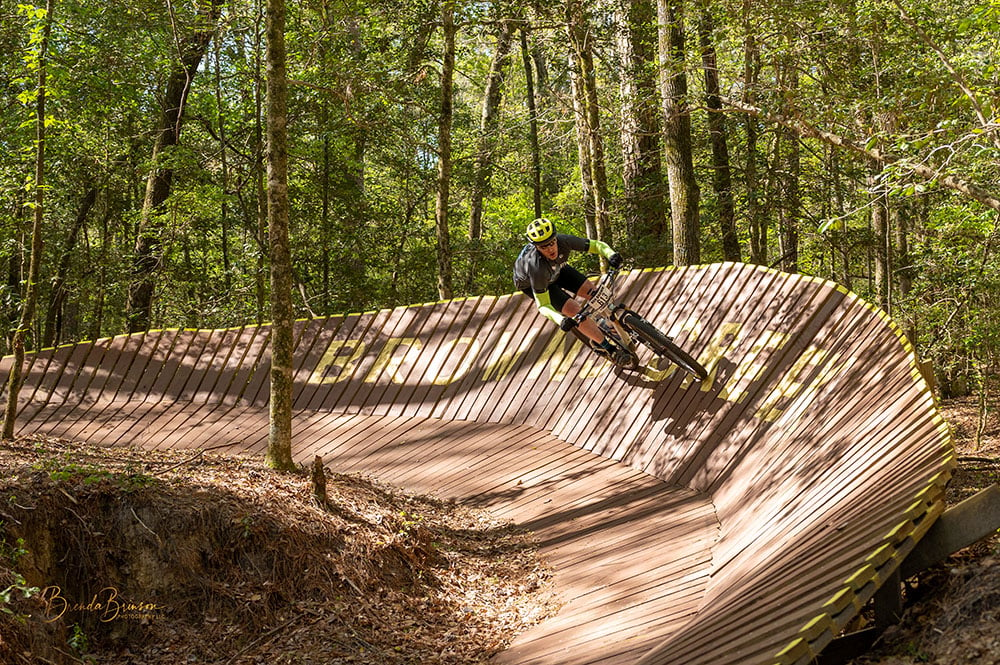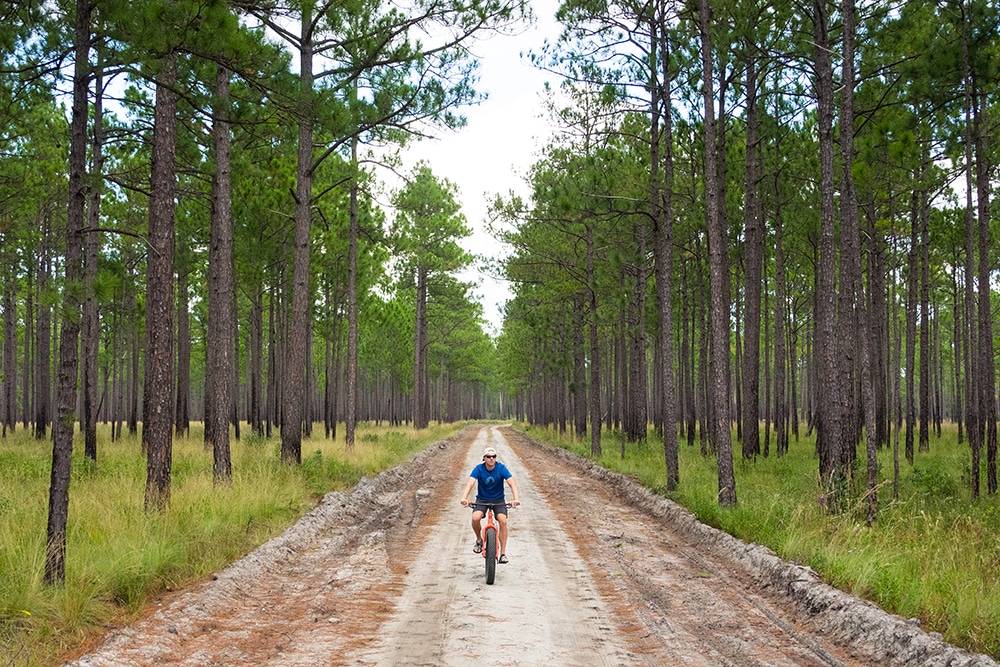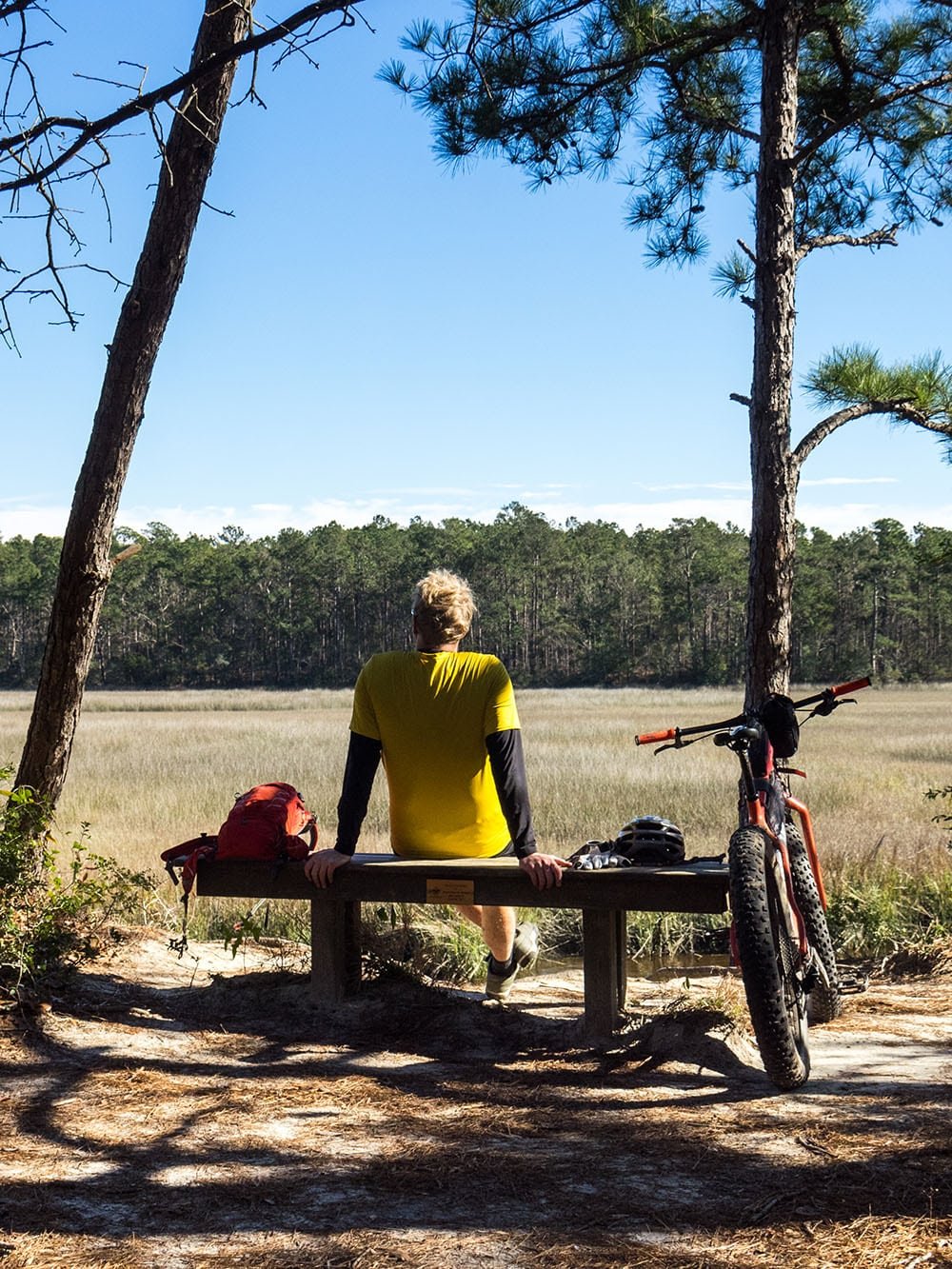Looking to shred singletrack near the sand, a mountain biker is pleasantly surprised.
When I first heard there was a seven-mile mountain bike trail in Myrtle Beach, I didn’t expect much. My wife had recently moved to teach in a nearby college town, and I followed a few months later after my final semester teaching in St. Louis. On the drive south, I detoured with a buddy for an impromptu bikepacking trip to the remote Big South Fork National Recreation Area on the Tennessee-Kentucky state line.
Several days later, I drove toward Myrtle Beach in prime riding condition with the goal to make things work—both as a freelancer and a mountain biker. Despite moving to a leisurely South Carolina beach town, I didn’t want to give my legs a break. I needed miles—and fast. Before I’d fully recovered, I drove with my bike over to Carolina Forest to check out the trail. On the way, it was housing developments, golf courses, and outlet malls as far as the eye could see, so my expectations were low. But pulling into the parking lot, my optimism rose when I saw riders with quality bikes zipping past on a trail through forested hills.
That first ride was a whirlwind of hairpin turns, carpet-covered berms, and flying jumps. The sandy singletrack included plenty of short but steep climbs and fast flowy descents. Officially called the Horry County Bike and Run Park, the trail is nicknamed The Hulk after its most challenging section: A plunging descent leading to a sharp jump, a sweeping berm, and an equally steep climb back up to the ridge. After my first lap, I was so impressed, I happily continued for a second lap. This time, I paid attention to the source of this surprising topography on the Coastal Plain, an area known for sandy flats and blackwater swamps, not mountain biking. The Hulk is a series of stacked loops built into 72 acres of vegetation-stabilized dunes and dredged sands left over from the construction of the Intracoastal Waterway, which borders the southeastern edge of the park.

While the Hulk quickly became my go-to ride, it didn’t offer as much mileage as I wanted. I was lucky to travel out West each year for work, so I wanted to maintain my legs for mountainous trails and multiday bike-packing trips. Most days at the Hulk, I’d had enough after three or four laps, partly due to fatigue and partly from the repetition. So, I started exploring outward from the Hulk. At first, I rode one of the area’s few paved cycling paths over the waterway and east through a construction zone—one of the many new housing developments being cut into cleared forest. At Pirates Voyage, I turned south. For many visitors, this dinner show is as adventurous as it gets, with scantily clad theater graduates swinging around on ropes while patrons eat exactly one half of a chicken. Yeah, we went.
From there, I rode surface streets and sidewalks to the beach. When the surface was packed by recent tides, I could ride it with my 2.2-inch tires. But when the sand was loose, I stuck to North Ocean Blvd, where people would scratch their heads at the lost mountain biker riding through a canyon of hotels. After turning north through neighborhoods, and making a harrowing sprint across Highway 17, I returned to the Hulk having logged either 31 or 38 miles. This was short of the 40- to 50-mile rides I wanted, but it would have to do.
During my second year in Myrtle Beach, there were several developments in my mountain biking adventures on the Coastal Plain. By now, I’d recognized the limitations of my narrow-tire cross-country bike. I’d also discovered how difficult it is to stay motivated with only one 7-mile trail and a tourist district to ride. When in town, I mostly just worked, exercised, and planned our next trips to the mountains. Living in a sandy region, I realized a bike with wider tires would open up new possibilities closer to home—plus, I could use it for rides in western deserts. So, I picked up a lightweight fat bike with 3.8-inch tires and started looking for new riding opportunities.
I’d heard there was a nature preserve just north of the Hulk. Channeling past bike-packing adventures, I decided to ride there. After briefly studying a map, I pedaled east on a dirt road and around a back gate into a country club community. Curious residents waved at the fully kitted-out fat biker casually riding past their million-dollar homes. Next came a short but nerve-wracking ride on the shoulder of a rural highway that led me to a sandy back road.
Lewis Ocean Bay Heritage Preserve is barely noticeable on most maps, but this state refuge offers over 10,000 acres of forest, shrubby pocosins, and wildlife. There are maybe 20 miles of sand roads for biking, walking, or driving. It was a great ride through scenic longleaf pine savannas, and I tried but failed to spot some of the 23 Carolina bays found within the preserve.
Up and down the Coastal Plain, there are thousands of Carolina bays, most of them elliptically shaped and pointing the same direction, which are much easier to see in satellite imagery. Many have dried up and filled with vegetation while others are seasonal swamps or year-round lakes. The mystery surrounding their origin eventually led me to Bladen County, N.C., where I explored some of the most intact bays by foot and boat. At Jones Lake State Park, a local hiker told me about a new mountain bike trail nearby, so I soon returned with my bike.

Browns Creek Bike Park is definitely the best trail I’ve ridden on the Coastal Plain. Currently, it offers 13 miles of surprisingly varied terrain, with lung-bursting climbs leading to flowing descents, sweeping curves, wooden berms, and plenty of rowdy jumps. Located in Elizabethtown, N.C., it’s about 35 miles southeast of the fall line, where the sands give way to the foothills of the Piedmont. The secret to Browns Creek’s success is that it’s built into rising hills just south of the upper Cape Fear River. Every lap involves over 500 feet of climbing and an equal amount of descent. Honestly, the trail feels like it was plucked out of the Appalachians and dropped onto the Coastal Plain.
As I continued looking, I found more worthy trails as well. I rode the easternmost sections of the Palmetto Trail, including the Awendaw Passage along a pleasant tidal creek, and the beefy 47-mile Swamp Fox Passage through the remote Francis Marion National Forest.
Though my wife and I had visited Wilmington, N.C., several times to hike through Carolina Beach State Park, I’d never taken my bike. So not long ago, I made a day trip to check out two trail systems. The older trails are at Brunswick Nature Park, with about seven miles of singletrack loops winding around bluffs above Town Creek. Options range from easy warm-ups to advanced grinds over roots and rocks. Plus, there’s a skills park with elevated bridges, logs, and jumps.
The real gem in Wilmington is Blue Clay Bike Park, with seven miles of flowy singletrack, including beginner and intermediate loops. With elevation so hard to come by, the Cape Fear SORBA trail builders used what was available—an old landfill. Don’t let that dissuade you from riding this excellent trail, with a mix of steady climbs, flowing drops, sweeping turns, and some jumps to keep it sporty. The trail is easy on the joints, and on my first visit I rode it three times and soon returned with my wife.
More trails are out there, and I still haven’t made it to those around Charleston or a newer one in Florence, S.C. While the area may never be a riding destination like Pisgah or Moab, with trails like the Hulk, Browns Creek, and Blue Clay, it’s an exciting time for mountain biking on the Coastal Plain.
Cover Photo: The author sits at Awendaw Passage. Photo Courtesy of the author







